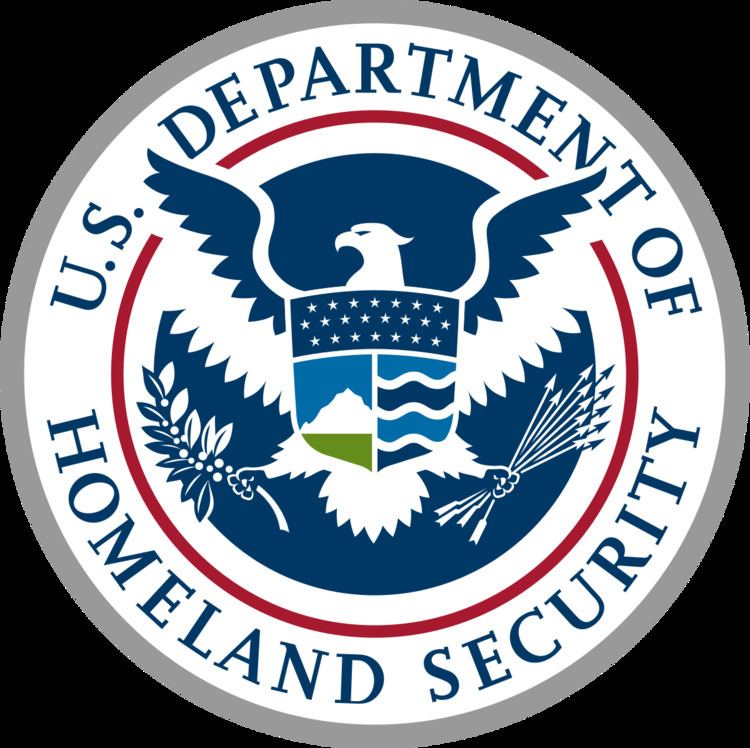Style Mr. Secretary Term length No fixed term | Seat Washington, D.C. | |
 | ||
Appointer The Presidentwith Senate advice and consent | ||
The United States Secretary of Homeland Security is the head of the United States Department of Homeland Security, the body concerned with protecting the U.S. and the safety of U.S. citizens. The secretary is a member of the President's Cabinet. The position was created by the Homeland Security Act following the attacks of September 11, 2001. The new department consisted primarily of components transferred from other cabinet departments because of their role in homeland security, such as the Coast Guard, the Federal Protective Service, U.S. Customs and Border Protection (which includes the Border Patrol), U.S. Immigration and Customs Enforcement (which includes Homeland Security Investigations), the Secret Service, and the Federal Emergency Management Agency (FEMA). It did not, however, include the FBI or the CIA.
Contents
- Inclusion in the presidential line of succession
- List of Secretaries of Homeland Security
- Living former Secretaries of Homeland Security
- Order of succession
- Bernard Kerik
- Raymond Kelly
- References
On January 20, 2009, the Senate confirmed Barack Obama's appointment of Janet Napolitano to be the third Secretary of Homeland Security, effective January 21, 2009. Napolitano resigned effective August 2013 to head the University of California. On October 17, President Obama announced his intention to nominate former General Counsel of the Department of Defense Jeh Johnson, and on December 16 the US Senate confirmed the nomination. The current Secretary, sworn in on January 20, 2017, is retired United States Marine Corps general John F. Kelly.
Inclusion in the presidential line of succession
Traditionally, the order of the presidential line of succession is determined (after the Vice President, Speaker of the House, and President pro tempore of the Senate) by the order of the creation of the cabinet positions, and the list as mandated under 3 U.S.C. § 19 follows this tradition.
On March 9, 2006, 43rd President George W. Bush signed H
List of Secretaries of Homeland Security
Prior to the establishment of the Department of Homeland Security, there existed an Assistant to the President for the Office of Homeland Security, which was created following the September 11, 2001, attacks.
Republican (2) Democratic (3) Independent (1)
Denotes acting Homeland Security Secretary
1 James Loy served as acting secretary in his capacity as Deputy Secretary of Homeland Security February 1—February 15, 2005.
2 Rand Beers served as acting secretary in his capacity as confirmed Undersecretary of Homeland Security for National Protection and Programs and Acting Deputy Secretary of Homeland Security; Beers was the highest ranking Senate-approved presidential appointee at the Department of Homeland Security from September 6, 2013 to December 23, 2013.
Living former Secretaries of Homeland Security
As of April 2017, there are four living former Secretaries of Homeland Security, the oldest being Tom Ridge (served 2003-2005, born 1945).
Order of succession
The order of succession for the Secretary of Homeland Security is as follows:
- Deputy Secretary of Homeland Security
- Under Secretary of Homeland Security for National Protection and Programs
- Under Secretary of Homeland Security for Management
- Assistant Secretary of Homeland Security for Policy (acting as Under Secretary-equivalent)
- Under Secretary of Homeland Security for Science and Technology
- General Counsel of the Department of Homeland Security
- Administrator of the Transportation Security Administration
- Administrator of the Federal Emergency Management Agency
- Commissioner of U.S. Customs and Border Protection
- Director of U.S. Immigration and Customs Enforcement
- Director of U.S. Citizenship and Immigration Services
- Chief Financial Officer
- Regional Administrator, Region V, Federal Emergency Management Agency
- Regional Administrator, Region VI, Federal Emergency Management Agency
- Regional Administrator, Region VII, Federal Emergency Management Agency
- Regional Administrator, Region IX, Federal Emergency Management Agency
- Regional Administrator, Region I, Federal Emergency Management Agency
Bernard Kerik
George W. Bush nominated Bernard Kerik for the position in 2004. However a week later, Kerik withdrew his nomination, explaining that he had employed an illegal immigrant as a nanny.
Raymond Kelly
By July 2013, Raymond Kelly had served as Commissioner of the New York City Police Department (NYPD) for nearly 12 straight years. Within days of Homeland Security Secretary Janet Napolitano's announcement that she was resigning, Kelly was soon cited as an obvious potential successor by New York Senator Charles Schumer and others.
During a July 16, 2013 interview, President Obama referred generally to the "bunch of strong candidates" for nomination to head the Department of Homeland Security, but singled out Kelly as "one of the best there is" and "very well qualified for the job".
Later in July 2013, the online internet news website/magazine "Huffington Post" detailed "a growing campaign to quash the potential nomination of New York City Police Commissioner Raymond Kelly as the next secretary of the Department of Homeland Security" amid claims of "divisive, harmful, and ineffective policing that promotes stereotypes and profiling". Days after that article, Kelly penned a statistics-heavy "Wall Street Journal" opinion article defending the NYPD's programs, stating "the average number of stops we conduct is less than one per officer per week" and that this and other practices have led to "7,383 lives saved—and... they are largely the lives of young men of color."
Kelly was also featured because of his NYPD retirement and unusually long tenure there in a long segment on the CBS News program "Sunday Morning" in December 2013, especially raising the question of the controversial "stop and frisk" policy in New York City and the long decline and drop of various types of crimes committed.
